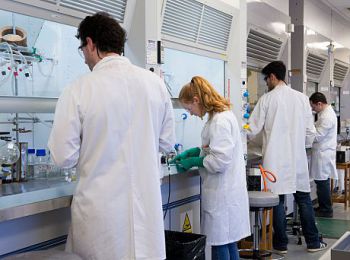Scientists to develop precision medicines which exploit DNA damage as treatments for cancer
By: Tom Furnival-Adams
Last updated: Thursday, 4 August 2016

Scientists at the University of Sussex are to create a portfolio of new cancer drugs which exploit our DNA damage response (DDR) system in order to kill cancer cells - in a bid to revolutionise treatment for the disease.
The £6 million project, funded by the Wellcome Trust and in collaboration with the pharmaceutical company AstraZeneca, brings together Sussex scientists’ deep understanding of the ways cells respond to DNA damage with cutting edge techniques of modern drug discovery to generate a powerful new approach to treating cancer.
DNA in healthy cells is damaged thousands of times daily, but the impact is reduced by the DDR system - a network of cellular pathways which identifies and repairs the damage. However, many cancers are known to have defects within these pathways – which enable cancerous cells to grow and divide.
The University of Sussex aims to harness its detailed understanding of DDR to discover drugs which can maximise DNA damage, or prevent its repair. AstraZeneca will have the first option to develop any compounds which are discovered. By treating patients with these drugs it’s hoped the cancer cells would accumulate an unsustainable amount of DNA damage - triggering them to die.
Healthy cells have an intact DDR system, and are not affected by these compounds suggesting that these drugs would have lower toxicity and possibly fewer side effects than traditional chemotherapies. The newly discovered compounds would also have the potential to increase the effectiveness of chemo and radiotherapy, which work by causing high levels of DNA damage.
Professor Simon Ward, Director of the University of Sussex’s Drug Discovery Centre, said: “Despite major advances in the treatment of cancer, there remains a substantial unmet need for highly specific drugs that selectively kill cancer cells.
“In order to create effective treatments for this disease - we must stop focusing on the cancer’s location and recognise the importance of targeting the genetic make-up of individual tumours. By designing drugs which exploit the defects in our DNA in order to kill cancer cells we can produce more effective treatments which have less side-effects for patients.
“Research projects of this nature require major investment, however it's only through bringing together a unique fusion of skills that we can hope to cross the divide from early research to revolutionary treatments for patients."
Susan Galbraith, Senior Vice President and Head of AstraZeneca’s Innovative Medicines and Early Development Unit, said: “DDR is one of AstraZeneca’s four key oncology platforms and we believe that our existing DDR portfolio, which includes the only marketed PARP inhibitor, Lynparza, is world leading. We are excited about the opportunity of working with scientists at the University of Sussex to discover new compounds with the potential to work at various stages along the DDR pathway.”
Steve Caddick, Director of Innovation at the Wellcome Trust, said: “We’ve arrived at a very exciting juncture in cancer research. For years, scientists have strived to untangle the early genetic events that destabilise the genome, causing a healthy cell to become a cancer cell. They are now beginning to use this knowledge to devise new drugs that selectively target only cancer cells, leaving healthy tissues intact. This type of precision therapy has the potential to be both more effective and have fewer side effects for patients.”
Professor Tony Carr, Director of Sussex University’s Genome Damage and Stability Centre, adds: “Discovery science underpins pretty much all modern cancer treatments and the development of new therapies, but it’s surprisingly hard to closely link discovery science with translational activities such as drug discovery and development.
“The opportunities to develop new drugs and new treatment regimes dependent on the genetic composition of a specific tumour are immense. This new funding will be an important step forward in exploiting our basic knowledge of DNA damage response mechanisms and tumour genotypes to identify new molecules that can exploit the same paradigm of synthetic sensitivity that underpins the success of the DNA repair inhibitor Olaparib.”

